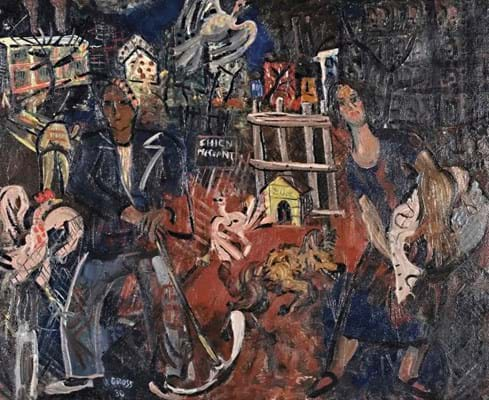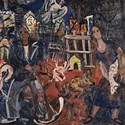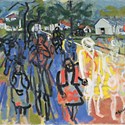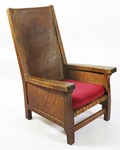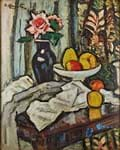As painter, draughtsman, printmaker and film animator, he appears to have suffered a fate similar to other under-represented Modern British artists whose talents stretched across multiple fields.
London-born Gross studied painting and engraving at the Slade before moving to Paris, where he married the fashion illustrator Marcelle Florenty. When war arrived, he evacuated his family on one of the last ships to leave Bordeaux in 1940.
Gross went on to produce more than 500 pictures during the conflict. He is even believed to have waded ashore during the D-Day landings, holding his painting materials over his head. After the war, he remained in France before buying a house in south-west England in 1955.
Non-war works
A group of seven oil paintings, dating from the late 1920s-’60s but containing no war works, turned up at Dreweatts’ (24/20/12% buyer’s premium) Fine Paintings sale in Donnington Priory, Berkshire, on November 28.
Assembled over the last 30 years by a private collector, the group improved upon hopes to total £19,200 – although the sum is likely to be considered modest for an artist of Gross’ calibre.
Picture specialist Jennie Fisher said the results were encouraging, particularly as “more and more of his work is coming onto the market, predominately out of private collections such as this one”.
Richard Gault, owner of London’s Redfern Gallery, which represents the artist’s estate, concurred. A “regular flow” of his work appears on the secondary market, he said, adding that the artist’s obvious talent but obscure status has made his paintings good value for money.
“There is something about Gross’ work. We’ve sold his paintings to Mod Brit collectors who have never heard of him but have fallen in love with a particular work. It is strange he is not a better-known figure,” Gault said.
That may change. According to Gault, a book on Gross’ war years is currently being written, and an exhibition of his work is in the offing at the Imperial War Museum in London, where some 600 of his war watercolours are held. For the moment, the most sought-after period at auction appears to be the oils and prints executed by Gross in the 1930s.
Factory theme
This rang true at Dreweatts where two canvases – Chien Mechant and La Zone – fetched the highest prices. They form part of a detailed series made in 1930-31 depicting factory workers in the industrial suburbs of Paris.
Chien Mechant, a 21in x 2ft 1in (54 x 65cm) oil on canvas, had been acquired from the artist’s daughter in 1988 and at one time had hung in the Tate. It was secured by a private buyer for £4800 against a £1500- 2000 estimate.
La Zone, similar in both style and size, was knocked down at £4600 against the same guide.
The pick of the later works was an unframed 21in x 2ft 2in (54 x 65cm) oil on canvas from 1954 titled Children going out to the fields. Also acquired from the artist’s daughter, it bettered its £1000-2000 guide to sell for £3800.


